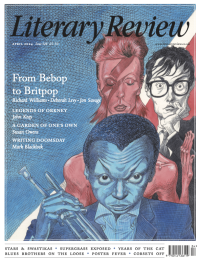Miranda Seymour
Poet for Our Time
On 17 April, the British Library is hosting a talk. Antonia Fraser and I will be having a ‘fireside chat’ about the subject of her latest book, Lady Caroline Lamb: A Free Spirit. If, that is, we can succeed in keeping Lord Byron at bay. April being the month of the bicentenary of Byron’s death, Lamb’s celebrated lover will be doing his utmost to hijack proceedings. History suggests that he may well triumph.
Fiona MacCarthy (in my view, Byron’s best biographer) wasn’t wrong when she called him ‘a public exhibitionist’. Nobody – not even Beyoncé, currently rediscovering her Texan roots in her new incarnation as a country and western singer – has surpassed Byron’s savvy use of image.
Part of the trick lay in the fact that Byron and his publisher never missed a chance to marry the strikingly handsome poet’s image to Byron’s work. Was it Byron’s idea, or was it John Murray’s, that Thomas Phillips, a close friend of the canny Scottish publisher, should produce, almost simultaneously, two carefully contrasted paintings of London’s new superstar? One (head and shoulders only) presented a moody, bare-necked thinker. Byron, always happy to show off his creamy throat, asked Phillips to render his nose more Roman and less retroussé. In 1814, that open-shirted portrait went on display at the Royal Academy alongside Phillips’s second, more flamboyant depiction of the author. Grandly titled Portrait of a Nobleman in the Dress of an Albanian, it was snapped up by the proud mother of Byron’s future wife and put on show in her country home. Murray bought the other work and gave it pride of place directly above the fireplace in his Albemarle Street drawing room. A copy hangs there still.
And Caroline? Phillips painted the future Lord Melbourne’s slender wife as a boyish page in the act of presenting a luscious bowl of fruits. He placed this daringly suggestive portrait between the two images of Byron in his studio, which was regularly visited by the London ‘ton’ (the posh set

Sign Up to our newsletter
Receive free articles, highlights from the archive, news, details of prizes, and much more.@Lit_Review
Follow Literary Review on Twitter
Twitter Feed
Under its longest-serving editor, Graydon Carter, Vanity Fair was that rare thing – a New York society magazine that published serious journalism.
@PeterPeteryork looks at what Carter got right.
Peter York - Deluxe Editions
Peter York: Deluxe Editions - When the Going Was Good: An Editor’s Adventures During the Last Golden Age of Magazines by Graydon Carter
literaryreview.co.uk
Henry James returned to America in 1904 with three objectives: to see his brother William, to deliver a series of lectures on Balzac, and to gather material for a pair of books about modern America.
Peter Rose follows James out west.
Peter Rose - The Restless Analyst
Peter Rose: The Restless Analyst - Henry James Comes Home: Rediscovering America in the Gilded Age by Peter Brooks...
literaryreview.co.uk
Vladimir Putin served his apprenticeship in the KGB toward the end of the Cold War, a period during which Western societies were infiltrated by so-called 'illegals'.
Piers Brendon examines how the culture of Soviet spycraft shaped his thinking.
Piers Brendon - Tinker, Tailor, Sleeper, Troll
Piers Brendon: Tinker, Tailor, Sleeper, Troll - The Illegals: Russia’s Most Audacious Spies and the Plot to Infiltrate the West by Shaun Walker
literaryreview.co.uk